Late November 1944, the 79th Infantry Division had pushed deeper in Alsace County and was now not far away from the town of Haguenau, symbolically a crossroad between France and Germany. The Saverne Gap battle was almost over, Strasbourg was liberated on the 23rd by the 2nd French Armored Division but some areas around it were not liberated and it was time to consolidate lines.
At the west of the town of Haguenau (2-hour walk) in a place called Berstheim 2nd Battalion of 315th Infantry Regiment closed in, on November 27th at the northeast to bivouac.
In the early hours of the 28th, orders and objectives from Regimental Commander were announced. 315th Infantry Regiment had to take the high grounds near villages of Batzendorf, Uhlwiller and Ohlungen. Those three objectives, are on a perfect straight line running from the south at Batzendorf to the north to Uhlwiller passing through Wintershausen (Wintershouse is the French name). For the 2nd Battalion, the idea was to break at Wintershausen and to use it as a backdoor entry into Ohlungen while the 1st Battalion would be fighting for Batzendorf and the 3rd for Uhlwiller.
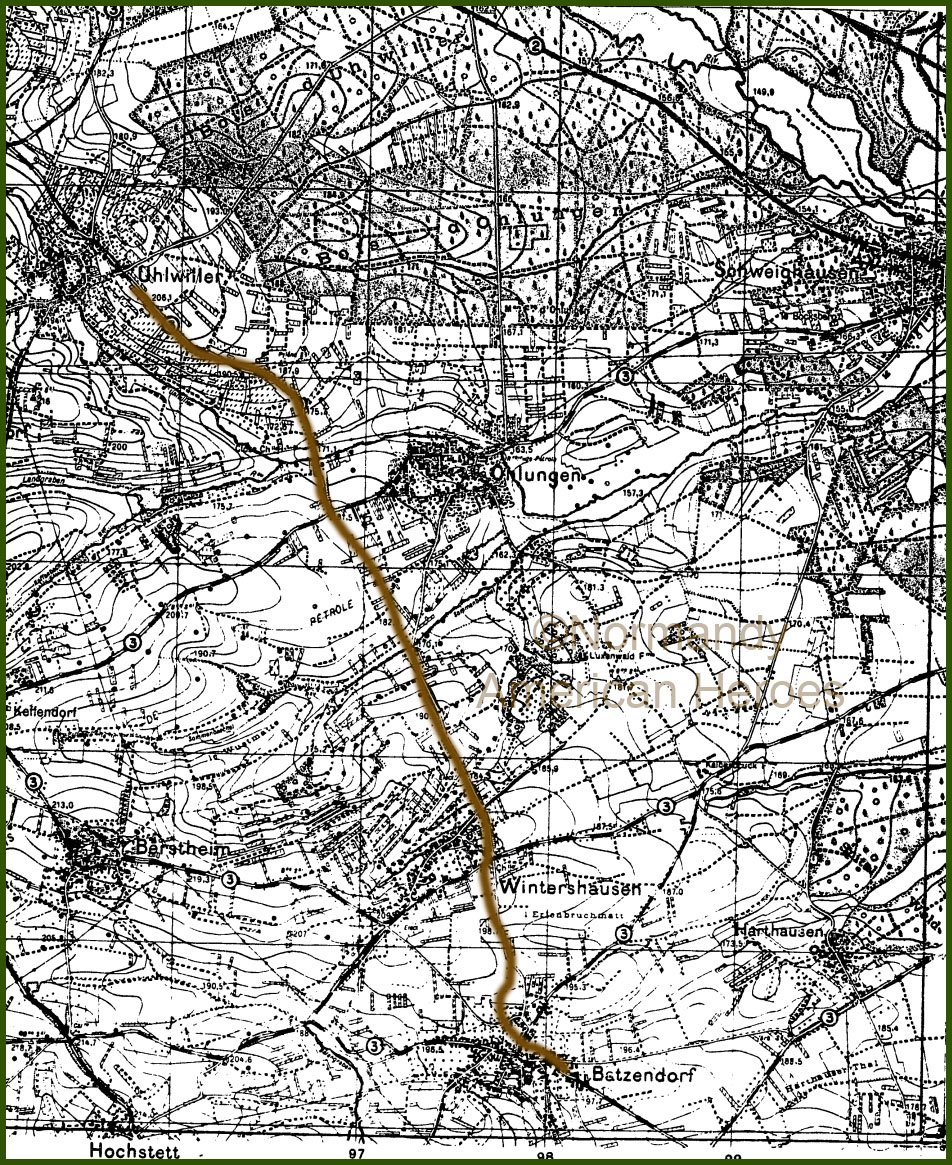
Jump off took place from where 2nd Battalion bivouacked, with “E” Company leading, “F” Company in the middle and “G” Company behind, while trying to stay hidden as long as possible behind the slope of Hill 190.5. With “E” Company in lead, and moving up the slope of Hill 190.5, it received some sniper fire, and small arm fire coming from Wintershausen. In response of this enemy fire, two 50mm machine guns were brought up on the crest of the hill but all of the sudden enemy fire stopped before the use of the two 50mm machine guns.
1st Platoon under the command of 2nd Lieutenant Robert R. Shirley was leading the attack, reinforced by the Weapons Platoon, and a Heavy Weapons Section from “H” Company attached to the 2nd Platoon. 1st Platoon had to be first in town to gain a foothold in few buildings for the rest of the company, to use it as protection for the upcoming house-to-house fighting.
Men composing 1st Platoon hit Wintershausen as planned at the northwest in the middle of the main street, some enemies were observed and opened fire but 1st Platoon didn’t answer. Men preferred to find out a way how to enter the first buildings as mostly of towns in Western France were walled but more so because of civilians. Locals had not vacated their homes and would not voluntarily open up their doors to the American troops.
At the same time, 2nd Platoon came into Wintershausen were 1st Platoon entered the town and turned right onto the main street to clean up the southwest part of the village. When finally men of the 1st Platoon found out a way to enter in some buildings, men started up the main street and went to the northeast to clean it up. At first, expectations were wrong, houses were found not harboring enemy soldiers but when 1st and 3rd Platoons had worked their way up to the point where the town fans out to the south, enemy resistance in strength was encountered.
For 2nd Lieutenant Shirley it was his first time in combat, and at about 75 yards from the "four corners" crossroad in town, he spotted four Germans. He fired upon them with his M1 Carbine but missed. Upon this little skirmish, the entire platoon pushed forward the enemies passing through the fenced yards that lined in main street.
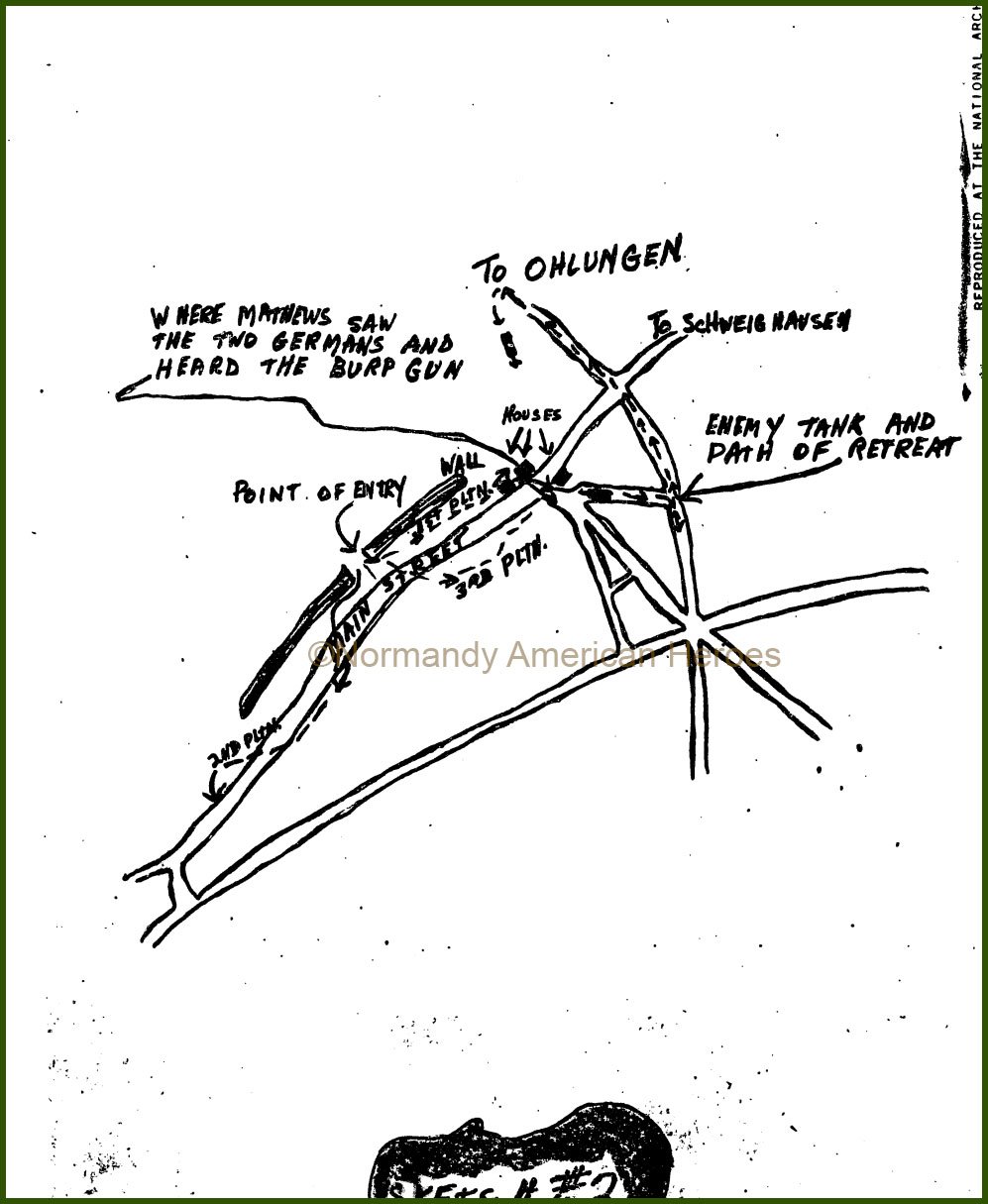
Private First-Class Boyd Matthews, armed of a BAR was the first to reach the "four corners" crossroad in town, he took position at the door of the house directly in front of it and opened fire on two Germans on the other side of the fence. Couple of seconds after he shot his last bullet, a “Burp” gun opened fire, Private First-Class Matthews guessed that it was just behind him, only a wooden fence separated them. He took his BAR over the fence and got all of gunners.
(Note: Five wounded or dead Germans were later found next to it.)
Once the gun silenced out, Private First-Class Matthews’s attention was called to an enemy Tiger Tank coming just in front of him accompanied by men on foot. Once again with his BAR Private First-Class Matthew got the two officers, and as a couple of their men rushed out to rescue them, a third one was wounded. While he was spraying death with his BAR, other members from his squad joined him but as the 88mm gun mounted on the Tiger swung in their direction, he yelled “Let’s get the hell out of here”. A hole several feet in diameter opened up in the wall where he and his comrades had been standing.
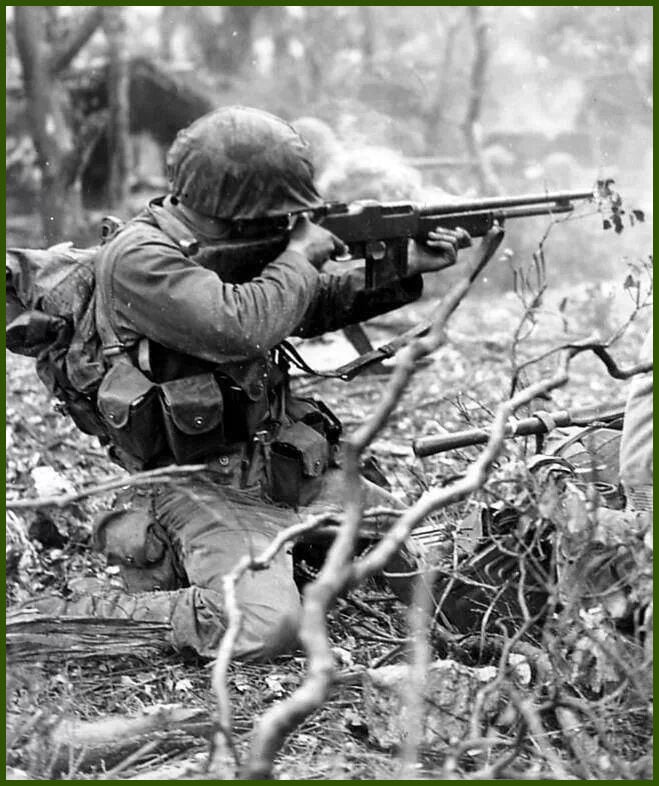
It was impossible for soldiers to deal against a 88mm gun mounted on a Tiger Tank so 2nd Lieutenant Shirley called for more fire toward it with a bazooka. Private Raymond E. Merritt who was next door figured out he could not get a direct shot at it with his bazooka. He ran back to the gate of the house they just left with his loader as he would have a better shot from there but he missed. Might be was he too much excited as tank was within the ideal range or because it was his first warfare experience? Nevertheless, confronted to enemy bazooka fire, tank started to retreat toward Ohlungen. Once it reached the outskirts of Wintershausen, gunners fired once again and it was the last resistance in town. “E” Company took defensive positions at the “four corners” crossroad with bazooka teams.
“F” Company which was in the middle, acting as a supporting unit arrived too late and didn’t take part of the men-tank fight. After scouting some houses at the southern part of the town, they took defensive positions and placed a roadblock where the Wintershausen road crosses the Berstheim – Batzendorf road. As for “G” Company the third and last unit of the 2nd Battalion, it followed during the all-day “F” Company. After being aware of the situation, both companies on orders took other defensive positions at the northeast of Wintershausen to be ready for the upcoming morning attack on Ohlungen the next day.
The tank met in Wintershausen during the afternoon was might be spotted by one patrol of “G” Company during the night on the road Wintershausen – Ohlungen. Being a serious threat patrol withdrew, it was the only patrol sent during the night. The patrol stated that Germans were shelling Ohlungen as hell from Schweighausen. (Schweighouse-sur-Moder is the French name)
By the end of the day all objectives were seized, 2nd Battalion controlled Wintershausen, 1st Battalion had Batzendorf and 3rd was in Uhlwiller. Once the line and foothold secured, it was time to capture Ohlungen. Same plan was issued except one section of heavy machine gun from “H” Company would be attached to each company and “G” would be the leading unit by cleaning out the east part of the town and “F” and “E” Companies following would have to clean up the southwest and north portions of Ohlungen.
(Note: “F” Company would have also to set up a roadblock on the road leading to Schweighausen.)
At 1100am on November 29th, “G” Company with its 1st Platoon in lead jumped off from its defensive positions at Wintershausen to assault Ohlungen by taking advantage of the cover of the landscape and vegetation, to mask its movements from enemy troops in town but also from Schweighausen, strongly armed with artillery fire. There were two vulnerable points along the route of march to Ohlungen, one in crossing the Ohlungen – Wintershausen road which might afford an observer in Ohlungen with an unobstructed view of troops on the road, the other in negotiating the distance between the stream and the woods south of town.
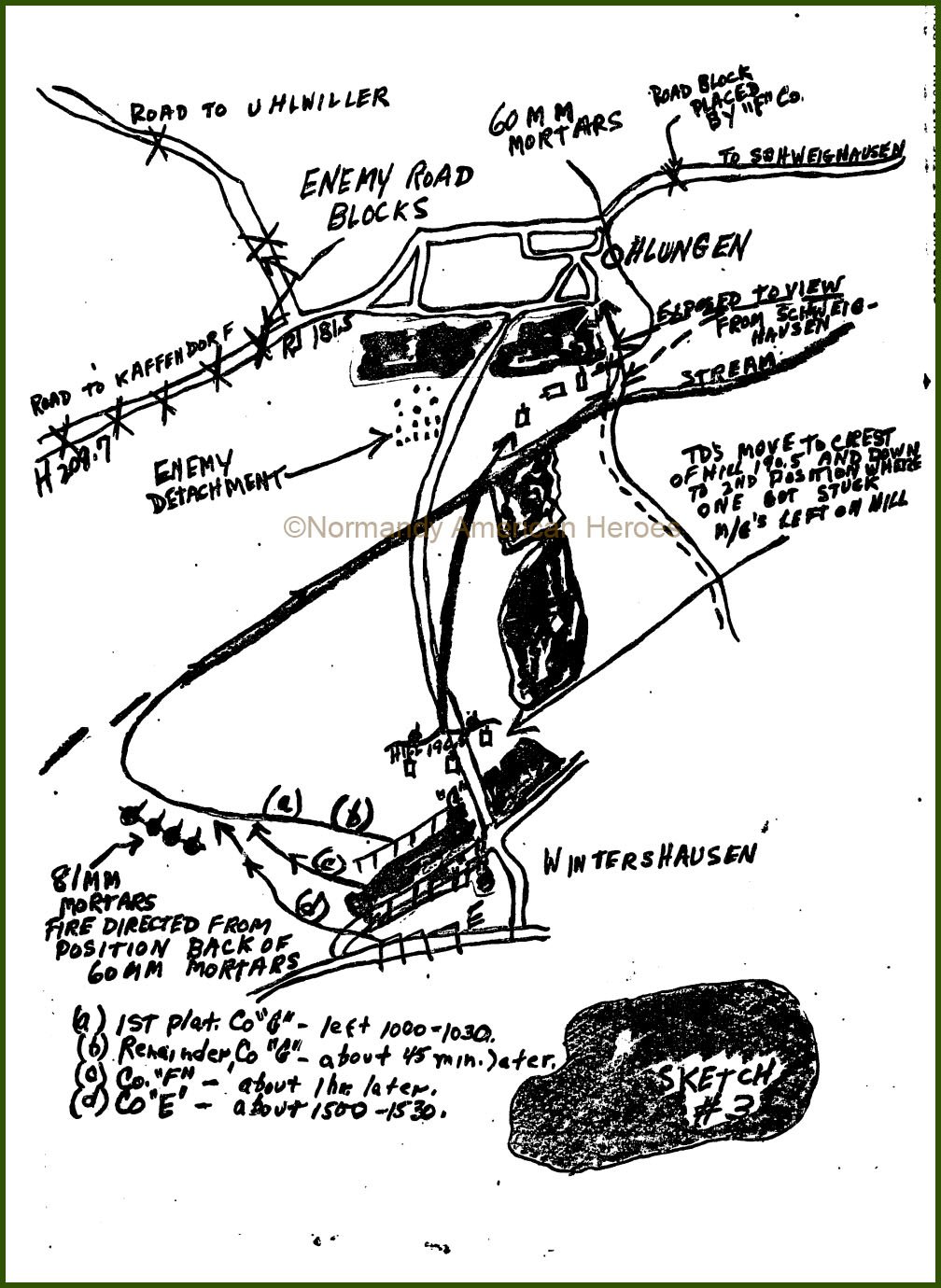
Couple of minutes after the jump off, 1st Platoon crossed the exposed area and entered the woods followed by the remainder of the company who were not as fortunate as the 1st Platoon. Indeed, receiving artillery fire from Schweighausen it gave evidence that the company and battalion were under enemy observation but no casualties were accounted for.
Commander of the battalion then called for a platoon of tank destroyers, those tanks went around the ridge of Hill 190.5 to cover “E” and “F” Companies on their way to the town. While moving all together side by side men and tanks received rocket launcher fire from a group of twenty enemy soldiers which was at the west of the road leading in town. To deal with them, heavy weapons attached to “F” Company dismounted to set up machine guns but to be sure that this enemy detachment would not be in the future a problem 60mm mortars supporting “G” Company fired on them while the small task force was moving.
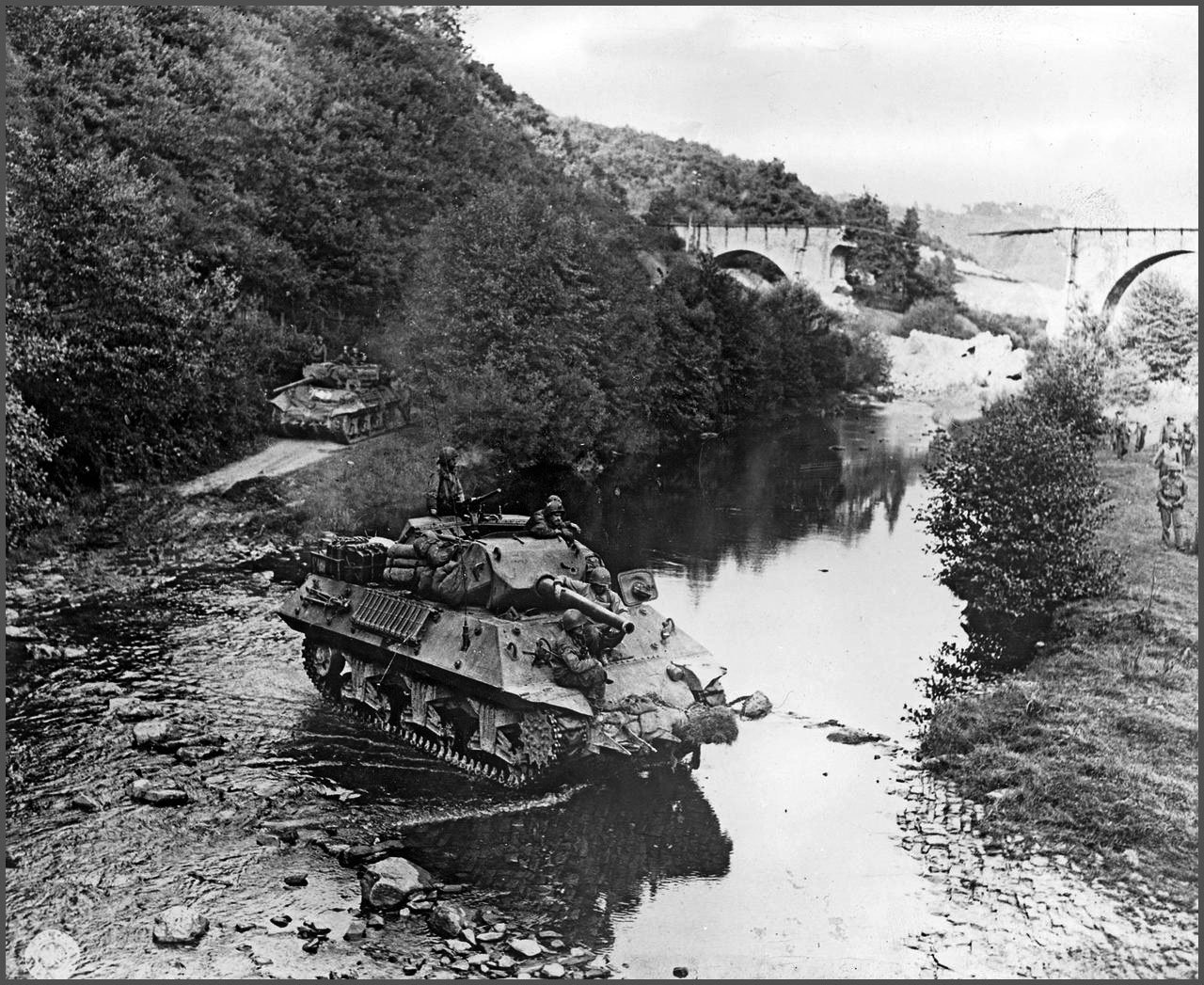
While men and vehicles were about to enter the town, machine guns were left behind to provide cover, precisely tanks proceeded cross-country toward the southeast corner of the town, and about midway between the town and stream one of them begged down. 1st Lieutenant Tennyson L. Nordstrom ran toward it and yelled to the drivers of the other ones to follow his lead except one which would have to stay to protect the one stuck.
When all of this happened, “G” Company was about to clean up Ohlungen. 1st Platoon had reached the first houses then started to clean up four or five houses, from those positions 2nd and 3rd Platoons would have a perfect view to cover 1st Platoon’s future actions in town.
1st Lieutenant David R. Harding entering the town with the second half of his company and saw two flares fired by the Germans pointed in his direction, those flares were signals calling for artillery fire from Schweighausen. A few moments later shells from 81mm and 120mm mortars were falling on him and his men. As “G” Company was split up, Captain called everyone back to regroup and instructed his 2nd and 3rd Platoons to take position on the road code named 181.5 (road running from Keffendorf to Ohlungen). 2nd and 3rd Platoons took position at the crossroad, 2nd on the right side and 3rd on the left were receiving machine gun fire but it turned to be ineffective.
From this point, enemy resistance consisted no more than occasional sniper fire and “G” Company started to clean out the town too, house by house. 1st Lieutenant Harding wanted to block all exits and to prevent any enemy reinforcements coming from the north, so 2nd Platoon occupied the west of the town, 1st Platoon the center, the 3rd Platoon was on the road leading to Schweighausen where a roadblock set up by Technical Sergeant Lewis E. Smith from 3rd Platoon of “F” Company was.
(Note: “F” Company had two outposts set up, one at the north and the other at the northeast.)
Once town under control around 0300pm, it was obtained through a civilian source that Germans had information which led them to believe that 79th Infantry Division planned to try to enter Ohlungen between 1100pm on November 24th, and 0400am on November 25th. And it was reported that the enemy retreating to Schweighausen during those hours shelled Ohlungen violently.
It was true! As mentioned above the night before the attack on Ohlungen, patrol from “G” Company which met the tank stated that it saw Germans shelling the town. 315th Infantry Regiment had the confirmation later that Germans whom had withdrawn from Ohlungen while the shelling took place and once over, came back and were responsible of the resistance that 2nd Battalion encountered.
At the time of the interview regarding the action of his unit 1st Lieutenant Harding was no longer a Lieutenant but was promoted Captain and was now in command of "E" Company.
Written by Pierre Fallet - Normandy American Heroes.

















